Our phones offer immediate access to personal and financial information, yet are often less protected than other devices such as computers and network systems. According to a TechInsurance survey, 62% of Americans are worried about mobile phone or computer security breaches. However, despite these growing concerns, many people, including company executives, do not take basic security precautions.
The TechInsurance survey found that 53% of mobile device users do not secure their phones. Because of the accessibility of mobile devices, cell phones have become the most recent target for hackers and outside security breaches. Here are 6 easy steps to protect your cell from security breaches:
1. Encrypt your Device
Encrypting your phone is an easy way to protect sensitive data. Most phones have an encryption setting which scrambles your phone’s data, making it unreadable to hackers. By entering the correct pin or password, your phone decrypts the data and makes it understandable. Attackers are unable to access the data without the encryption key, protecting your sensitive personal data and reducing your risk of unauthorized access.
The easiest way to encrypt your phone is to have a passcode for it. If you don’t already, create a password that is unique and not easily guessable. If you select “passcode options”, it will give you the choice to set a custom numeric code or set a custom alphanumeric code, which allows you to set a passcode that includes letters and numbers. Once your password is set, you should see “data protection is now enabled” which means your phone is now encrypted and only you can access your device’s data.
2. Make Sure Free or Public WIFI is Protected
Free and public wifi has become increasingly popular and is easily accessible to users. While it may seem like a great alternative to avoid using up your data plan, public wifi is not always the most secure. It provides cyber criminals with easy access into your phone and gives them a gold mine of personal data.  While using free and public wifi, it is important not to use any passwords or sign into any accounts that hold sensitive information such as banking or email accounts. While public wifi may be okay for a quick web search, it is important to be aware of the security risks and switch back to your mobile data plan if you need to access other important applications or files.
While using free and public wifi, it is important not to use any passwords or sign into any accounts that hold sensitive information such as banking or email accounts. While public wifi may be okay for a quick web search, it is important to be aware of the security risks and switch back to your mobile data plan if you need to access other important applications or files.
One way to help secure your phone from public wifi threats is to use a virtual private network (VPN). As written by Forbes Magazine, “A VPN is software that encrypts your wireless session across a public network.” Some phones come with a VPN already installed, while others can download one through the app store at a relatively cheap price. This helps secure your phone and takes preventative security measures to help make your phone as secure as possible while using wifi.
3. Set up a Remote Wipe
While losing your phone can already a huge inconvenience, it can give others access to your personal information and data if you have not secured your device. This is why it is important to download applications such as “Find my iPhone” or “Android Device Manager” that allow you to track and remotely wipe your device when your phone becomes lost or stolen. The remote wipe occurs when the phone first connects to the internet- preventing the information on your phone from being accessed. This is an easy step to take that can help to relieve the stress of a loss or stolen phone, and it helps to reduce the risk of others accessing sensitive information.
4. Install Anti-Malware Applications
While many understand the importance of using anti malware and virus packages for their laptops or computers, the majority of people do not take the same security precautions to protect their mobile devices. There are various different and nasty malware and viruses out there, which is why it is important to stay protected.
Many third party applications are not monitored or vetted by app stores such as Google Play and iTunes. These apps are less secure and can be a dangerous hide out for malware and viruses. While iPhones only allow apps to be downloaded through iTunes, many people get around this by jailbreaking their phones in order to download third-party applications. This provides a window for hackers to access personal information and increases security risks.
If you do decide to download a third party app, it is important to read reviews and avoid entering too much personal information. With anti-malware applications, your phone is protected if you click a malicious link or download a malicious application, and it can help prevent a security breach or infection. While it may seem like an extreme measure, it is better to be safe than sorry when it comes to malware and viruses.
5. Update Operating Systems Often
While continuous update pop-ups can be annoying, it is important to constantly update your phone as frequently as you would your laptop or computer. The drainage of battery and prolonged update time prevents many users from updating their phones. However, the longer a user waits to update, the more time hackers have to exploit security vulnerabilities in the system. There are operating flaws in each system, and eventually, cybercriminals are bound to find the weaknesses in the system. Updating your phone software consistently helps to fix these flaws in the system and keep your phone secure and protected. Even if software updates do not introduce many new features, it is important to keep updating for security purposes. With each “maybe later” button you hit to prolong that software update, you are giving hackers a longer window of opportunity to access your information.
The drainage of battery and prolonged update time prevents many users from updating their phones. However, the longer a user waits to update, the more time hackers have to exploit security vulnerabilities in the system. There are operating flaws in each system, and eventually, cybercriminals are bound to find the weaknesses in the system. Updating your phone software consistently helps to fix these flaws in the system and keep your phone secure and protected. Even if software updates do not introduce many new features, it is important to keep updating for security purposes. With each “maybe later” button you hit to prolong that software update, you are giving hackers a longer window of opportunity to access your information.
6. Turn Off Your Phone’s Bluetooth Unless It Is Being Used
Hackers can access your phone’s bluetooth using techniques called bluesnarfing and blue-hacking. Bluesnarfing is when hackers access and download your phone’s personal data by connecting to your bluetooth. According to author Steve Bell, “Bluebugging allows hackers to make calls, send text messages and access the Internet via the device’s connection as well as accessing personal information.” Hackers can set up software that searches for devices with active bluetooth connections with security vulnerabilities. This type of hacking must be performed within 10 meters from the phone, but if your phone is breached it will give no warning to its owner. Leaving your bluetooth on can endanger your phone’s sensitive data and allow hackers to make phone based payments or install malware onto your cell. In order to prevent this, only use your device’s bluetooth when necessary and establish two factor authentications on your accounts.
Much like computers, mobile devices have security flaws. With the amount of personal data and information that is stored in your phone, it is important to protect certain vulnerabilities. While many users take basic security measures, such as installing a passcode for their phones, it is essential to take it a step further by using these simple and easy tips to ensure your device is secure. With over 5 million mobile phone users around the world, it is more important than ever to take preventative measures to protect yourself and your information.
Categories: Security, Office Hacks











